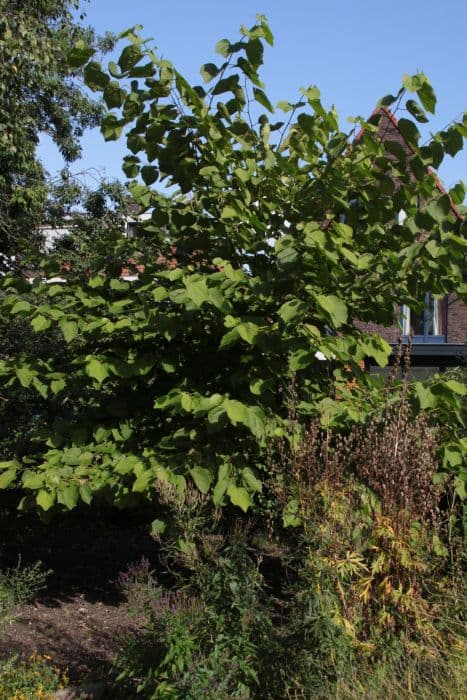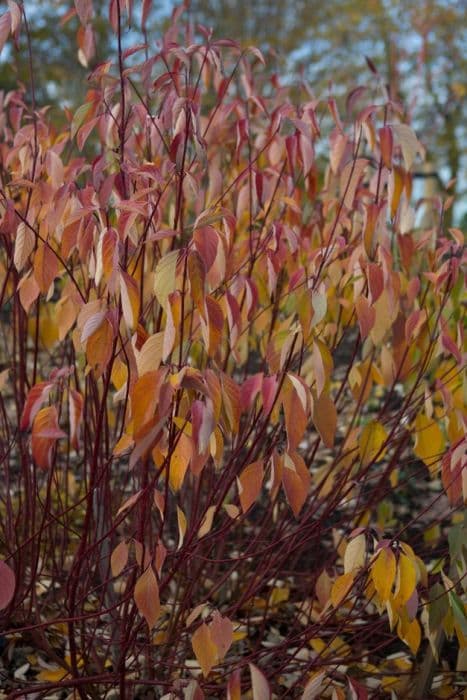Bentham's Cornel Cornus capitata











ABOUT
Cornus capitata, commonly known as the Himalayan strawberry tree, has a distinct and attractive appearance. It is adorned with broad, dark green leaves that are oval-shaped and have a leathery texture. The foliage may turn red or purple as the seasons change, adding a touch of color to the landscape. This plant is particularly noted for its large, showy flowers, which are not true flowers but rather a whorl of large, creamy-yellow bracts surrounding a cluster of small, inconspicuous greenish-yellow florets. These 'flowers' can have a subtle, sweet fragrance and are followed by fruit that resembles strawberries, starting out green and turning to a bright red or yellow as they ripen. The fruit can add aesthetic value and attract wildlife such as birds to the garden. The overall form of the Himalayan strawberry tree can be quite striking, with a layered, branching pattern that provides visual interest throughout the year.
About this plant
 Names
NamesFamily
Cornaceae.
Synonyms
Bentham's Cornel, Evergreen Dogwood, Himalayan Strawberry Tree, Himalayan Flowering Dogwood.
Common names
Benthamia capitata, Benthamidia capitata, Dendrobenthamia capitata, Dendrobenthamia hongkongensis.
 Toxicity
ToxicityTo humans
The Himalayan strawberry tree is not commonly known for being toxic to humans. There is limited information on its toxicity, as it is not typically considered a hazardous plant. Thus, if there is any potential toxicity, it likely does not cause severe or widespread issues. However, as with any plant, individual allergic reactions or sensitivities can occur, and ingesting unknown plants or plant parts is generally discouraged. If a person experiences adverse effects after consuming any part of the Himalayan strawberry tree, they should seek medical advice.
To pets
The Himalayan strawberry tree is not widely recognized as toxic to pets. There is a lack of substantial evidence regarding its toxicity in animals such as dogs and cats. If a pet ingests part of the Himalayan strawberry tree and displays signs of illness, contact a veterinarian. Symptoms such as vomiting, diarrhea, or unusual behavior could be indicative of an adverse reaction and should be evaluated by a professional.
 Characteristics
CharacteristicsLife cycle
Perennials
Foliage type
Evergreen
Color of leaves
Green
Flower color
Yellow
Height
20 feet (6 meters)
Spread
15 feet (4.5 meters)
Plant type
Tree
Hardiness zones
8
Native area
Himalayas
Benefits
 General Benefits
General Benefits- Ornamental Value: This plant, also known as the Himalayan Strawberry Tree, has an attractive appearance with large, showy, cream-colored to yellow bracts that resemble flowers, providing aesthetic value to gardens and landscapes.
- Wildlife Attraction: The fleshy fruit attracts birds and other wildlife, which can help promote biodiversity and contribute to a healthy ecosystem.
- Shade Provision: Cornus capitata can grow into a small to medium-sized tree that can provide shade in gardens, parks, and urban environments.
- Windbreak: It can serve as a windbreak, protecting other plants and reducing soil erosion when planted in rows or groups.
- Drought Tolerance: Once established, the Himalayan Strawberry Tree can tolerate periods of dryness, making it suitable for water-conscious gardens or regions with less rainfall.
- Screening Plant: Its dense foliage allows it to act as a natural screen, providing privacy and reducing noise in landscaped areas.
 Medical Properties
Medical Properties- Antioxidant: Cornus capitata is believed to have antioxidant properties.
- Antimicrobial: Elements of the plant may exhibit antimicrobial activity against certain pathogens.
- Anti-inflammatory: It may contain compounds that help reduce inflammation.
- Astringent: The bark or leaves might be used for their astringent qualities.
 Air-purifying Qualities
Air-purifying QualitiesThis plant is not specifically known for air purifying qualities.
 Other Uses
Other Uses- Cornus capitata leaves can be used as a natural dye source for fabrics, providing a range of colors from the tannins present in the leaves.
- The fruit of Cornus capitata, though not particularly tasty, can be used to make a rudimentary type of wine through fermentation processes.
- The evergreen foliage of Cornus capitata is sometimes used in floral arrangements, especially around the Christmas season for its bright, festive appearance.
- Wood from the Himalayan Strawberry Tree can be utilized in small woodworking projects, including carving and turning to create decorative items.
- The dense canopy of Cornus capitata can be strategically planted to provide shade in gardens and reduce cooling costs in nearby buildings.
- The fibrous bark from the tree may be used in the creation of natural ropes or cordage in a survival or traditional craft context.
- When planted in groups, Cornus capitata can act as a windbreak, helping to protect more sensitive plants and reducing soil erosion.
- The habit of the tree makes it suitable for bonsai, enabling enthusiasts to manipulate its form for artistic expression in miniature landscaping.
- In educational settings, Cornus capitata can be used to demonstrate plant propagation techniques, such as air layering or stem cuttings, due to its moderate growth rate.
- The nectar and pollen of their flowers can serve to attract pollinators such as bees, butterflies, and birds, enhancing biodiversity in gardens and landscapes.
Interesting Facts
 Feng Shui
Feng ShuiThe Himalayan Dogwood is not used in Feng Shui practice.
 Zodiac Sign Compitability
Zodiac Sign CompitabilityThe Himalayan Dogwood is not used in astrology practice.
 Plant Symbolism
Plant Symbolism- Love and Affection: Cornus capitata, commonly known as Himalayan Strawberry Tree, is often associated with love and affection due to its heart-shaped leaves, symbolizing the giving or receiving of love.
- Resilience and Strength: This plant's ability to grow in various conditions and withstand different climates signifies resilience and the strength to endure hardships.
- Renewal: The Himalayan Strawberry Tree blooms in spring, making it a symbol of renewal and rebirth, signifying new beginnings and fresh starts.
- Purity and Innocence: The white to pale yellow flowers of Cornus capitata represent purity and innocence, reflecting untainted beauty and a sense of serenity.
 Water
WaterThe Himalayan Strawberry Tree (Cornus capitata) requires consistent moisture and should be watered thoroughly, ensuring the soil is moist but not saturated. During the active growing season in spring and summer, water weekly with about 1-2 gallons per plant, depending on the size and the weather conditions. In the fall and winter, reduce the frequency to biweekly or when the soil feels dry to the touch. Always adjust the watering schedule based on rainfall; less water is needed during periods of heavy rain. Overwatering can lead to root rot, so it’s crucial to have well-draining soil.
 Light
LightThe Himalayan Strawberry Tree thrives best under full sun to partial shade conditions. It should receive at least four to six hours of direct sunlight daily. An ideal spot would offer morning sunlight and afternoon shade, especially in hotter climates, to prevent leaf scorch.
 Temperature
TemperatureThe Himalayan Strawberry Tree prefers a temperate climate with temperatures ranging from 60°F to 75°F for optimal growth. It can survive minimum temperatures down to around 15°F in winter, but frost can cause damage to the foliage and flowers. The plant is more vulnerable to extreme heat, and high temperatures above 90°F may stress the plant; therefore, some shade may be beneficial in hot climates.
 Pruning
PruningPrune the Himalayan Strawberry Tree to maintain its shape and to remove any dead, diseased, or crossing branches. The best time for pruning is in late winter or early spring before new growth begins. Light pruning can be done annually; however, more extensive pruning should be done less frequently, ideally every two to three years, to allow the tree to recover.
 Cleaning
CleaningAs needed
 Soil
SoilThe best soil mix for Himalayan Strawberry Tree (Cornus capitata) should be well-draining, rich in organic matter, and slightly acidic to neutral in pH, ranging between 6.0 and 7.0. A mix containing loam, peat, and coarse sand or perlite is ideal to ensure proper drainage and aeration.
 Repotting
RepottingHimalayan Strawberry Tree does not require frequent repotting; it should be repotted every 2-3 years or when it outgrows its current container, which is typical for slowly growing trees.
 Humidity & Misting
Humidity & MistingHimalayan Strawberry Tree prefers moderate to high humidity levels. Maintaining humidity around 50-60% is ideal for this plant, replicating its native subtropical habitat.
 Suitable locations
Suitable locationsIndoor
Place in bright, indirect light and keep away from dry heat sources.
Outdoor
Plant in partial shade with shelter from strong winds and frost.
Hardiness zone
8-9 USDA
 Life cycle
Life cycleCornus capitata, commonly known as the Himalayan Strawberry Tree, starts its life as a seed, often dispersed by birds that feed on its fruit. Once the seed germinates, it develops into a seedling with a basic root system and foliage ready for photosynthesis. As the seedling matures, it grows into a young plant or sapling, gradually forming a woody stem and a more extensive root system. The sapling then enters an extended period of vegetative growth, where it increases in height and girth, developing the characteristic structure of the Himalayan Strawberry Tree. Upon reaching maturity, the plant produces flowers, usually in late spring and summer, which are pollinated by insects, leading to the development of strawberry-like fruits. Following fruiting, the cycle continues as seeds are spread anew, and the parent plant may enter a period of dormancy during colder months before resuming growth in spring.
 Propogation
PropogationPropogation time
Spring-early summer
Propogation: The Himalayan Strawberry Tree, Cornus capitata, is often propagated through seed sowing. The ideal time to sow seeds is in the fall or early winter. Fresh seeds have a higher germination rate and should be collected as soon as the fruit is ripe, gently cleaned, and sown in a cold frame. Stratification, a process of chilling the seeds for a period, can improve germination rates, and this can be naturally achieved through the winter cold. It can take one to two years for the seedlings to be ready for transplanting into the garden. Seed propagation is often considered the most popular method for this species due to the ease of collecting seeds and the plant's natural reproduction strategy.









